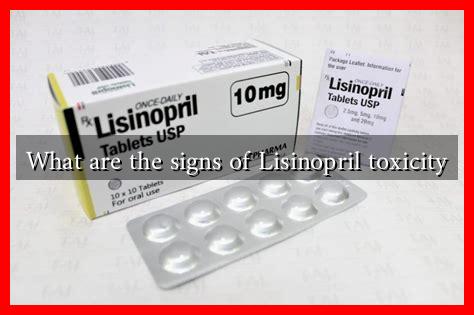-
Table of Contents
What are the Signs of Lisinopril Toxicity?
Lisinopril is a widely prescribed medication belonging to the class of angiotensin-converting enzyme (ACE) inhibitors. It is primarily used to treat high blood pressure and heart failure, and to improve survival after a heart attack. While Lisinopril is generally safe when taken as directed, toxicity can occur, leading to serious health complications. Understanding the signs of Lisinopril toxicity is crucial for patients and healthcare providers alike.
Understanding Lisinopril and Its Mechanism
Lisinopril works by inhibiting the enzyme that converts angiotensin I to angiotensin II, a substance that narrows blood vessels. By blocking this process, Lisinopril helps to relax blood vessels, thereby lowering blood pressure and reducing the workload on the heart. However, improper dosing or interactions with other medications can lead to toxicity.
Signs and Symptoms of Lisinopril Toxicity
Recognizing the signs of Lisinopril toxicity is essential for timely intervention. The symptoms can vary in severity and may include:
- Hypotension: A significant drop in blood pressure can lead to dizziness, fainting, or even shock.
- Hyperkalemia: Elevated potassium levels can cause muscle weakness, fatigue, and irregular heart rhythms.
- Renal Dysfunction: Symptoms may include decreased urine output, swelling in the legs, and fatigue.
- Cough: A persistent dry cough is a common side effect of Lisinopril, but it can also indicate toxicity.
- Angioedema: This serious condition involves swelling of the face, lips, tongue, or throat, which can obstruct breathing.
- Rash or Itching: Allergic reactions may manifest as skin rashes or itching.
Case Studies and Statistics
Research indicates that Lisinopril toxicity is relatively rare but can occur, especially in patients with pre-existing conditions. A study published in the Journal of Clinical Hypertension found that patients with renal impairment are at a higher risk for developing toxicity. In one case, a 65-year-old male with chronic kidney disease experienced severe hypotension and hyperkalemia after a dosage increase of Lisinopril. This case highlights the importance of monitoring renal function in patients taking this medication.
According to the American Heart Association, approximately 30% of patients on ACE inhibitors like Lisinopril may experience side effects, with a smaller percentage developing serious complications. This underscores the need for healthcare providers to educate patients about the potential risks associated with Lisinopril.
Risk Factors for Lisinopril Toxicity
Several factors can increase the risk of Lisinopril toxicity, including:
- Renal Impairment: Patients with kidney issues may have difficulty excreting the drug, leading to accumulation in the body.
- Dehydration: Insufficient fluid intake can exacerbate the effects of Lisinopril, increasing the risk of hypotension.
- Drug Interactions: Certain medications, such as potassium-sparing diuretics or NSAIDs, can interact negatively with Lisinopril.
- Age: Older adults may be more susceptible to side effects due to changes in metabolism and organ function.
Conclusion
In summary, while Lisinopril is an effective medication for managing hypertension and heart failure, it is essential to be aware of the signs of toxicity. Symptoms such as hypotension, hyperkalemia, renal dysfunction, and angioedema should not be ignored. Patients, especially those with risk factors, should be closely monitored by healthcare providers. Early recognition and intervention can prevent serious complications and ensure the safe use of Lisinopril. If you suspect Lisinopril toxicity, seek medical attention immediately.
For more information on Lisinopril and its effects, you can visit the Drugs.com Lisinopril page.

